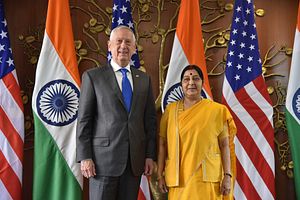In the end, it was the strategic logic of the bilateral partnership that was on display at the recently concluded India-United States “2+2” talks. The transactionalism of the Trump administration, of much concern to Indian commentariat, was relegated to the margins and for good reason and at least for the time being. Washington and New Delhi can hail the upward momentum in the relationship’s trajectory. It is clear that India and the United States want to see their relationship evolve into a more robust strategic engagement. And both sides are not shy of being ambitious.
The format of the dialogue itself is indicative of a new maturity in the relationship, which, according to U.S. Secretary of State Mike Pompeo, seems to have entered “a new era,” and is “symbolic of our increasingly close partnership.” Such a dialogue is important as it will keep the conversation focused at the strategic level allowing the two to tackle more tactical problems that will continue to bedevil the relationship from time to time.
The convergence was further underlined by the two main outcomes of the dialogue: the signing of the long-pending Communications Compatibility and Security Agreement (COMCASA) and setting up of a hotline between the Indian External Affairs Minister and Defense Minister with their American counterparts. After being under consideration for more than a decade, the Modi government finally took the decisive action of signing COMCASA, which will enable the transfer of communication security equipment from the United States to India, facilitating “interoperability” between the two defense forces as well as with other militaries that use U.S.-origin systems for secured data links.
It is one of the four so-called foundational agreements that the United States signs with its close partners for enhancing interoperability between militaries and will facilitate access to advanced defense systems, thereby allowing India to more efficiently utilize its existing U.S.-origin platforms. After signing the General Security of Military Information Agreement (GSOMIA) in 2002 and the Logistics Exchange Memorandum of Agreement (LEMOA) in 2016, the final agreement to be negotiated between India and the United States now remains the Basic Exchange and Cooperation Agreement for Geo-spatial Cooperation (BECA).
While the two nations are taking their joint military training up a notch by deciding to conduct a tri-services joint exercise off the eastern coast of India in 2019, the deployment of an Indian liaison officer at the U.S. Naval Forces Central Command (NAVCENT), which is responsible for naval operations in Afghanistan, Pakistan, and the oil-rich Gulf countries is even more significant. The message to Pakistan was unambiguous with the Secretary of State and Indian External Affairs Minister Sushma Swaraj calling on Pakistan to ensure that their territory was not used to launch terrorist attacks on other countries in their joint statement. As Swaraj underlined, “We have discussed terror emanating from Pakistan and have agreed that Pakistan needs to do a lot more to curb terror originating from it” even as they were unequivocal about their support for an Afghan-led, Afghan-owned peace and reconciliation process. This assumes greater importance in light of reports that the United States has had recent back-channel talks with the Taliban in Doha.
The India-U.S. convergence on Pakistan was even more striking coming as it did after Pompeo’s short five-hour visit to Islamabad, where the tension in the air was palpable. The Trump administration’s recent announcement that it would suspend a $300 million tranche in Coalition Support Fund reimbursements to Pakistan has unnerved the new government of Prime Minister Imran Khan, which was hoping to get the benefit of doubt usually reserved for new governments. But this was the second major U.S. cut in security assistance to Pakistan this year, underscoring the reality that patience with Pakistan is running thin in Washington. Pompeo rubbed it in when he suggested that the Pakistani government had been told in advance about the impending sanctions and that the Trump administration is yet to see “the progress that we need to see from them.” Where the United States is still trying to settle old scores with Pakistan, India-U.S. ties are about the future.
Defense cooperation continues to drive the relationship. U.S. Secretary Of Defense Jim Mattis made it clear that the United States “will continue working together, join hands and expand India’s role as a primary major defense partner, to elevate our relationship to a level commensurate with our closest allies and partners.” Moving defense engagement a notch higher, the two nations are now focused on enhancing closer private defense industry collaboration which will help Indian defense manufacturers join the U.S. military supply chain, thereby boosting the Modi government’s “Make in India” initiative. Innovation is at the heart of this defense collaboration for which a Memorandum of Intent was signed between the U.S. Defense Innovation Unit (DIU) and the Indian Defense Innovation Organization — Innovation for Defense Excellence (DIO-iDEX).
The larger strategic realities continue to shape India-U.S. engagement as well. This was evident, for example, when the joint statement talked of the need “to ensure freedom of the seas, skies, uphold the peaceful resolutions of the maritime disputes, promote market-based economics and good governance and prevent external economic coercion.” Though there are some divergences between the United States and Indian conceptions of the Indo-Pacific, the fundamental reality of the above statement makes the two real partners in their endeavor to promote a prosperous, free, and equitable regional order.
The two issues on which there was much discussion before the dialogue — Russia and Iran — ended up being footnotes to the broader convergence between India and the United States. While tensions remain in so far as their resolution is concerned, it was evident from the 2+2 dialogue’s first edition that two of the world’s major democracies are willing to bet on the multitude of factors that bring them together as opposed to harping on the few challenges in the way.

































